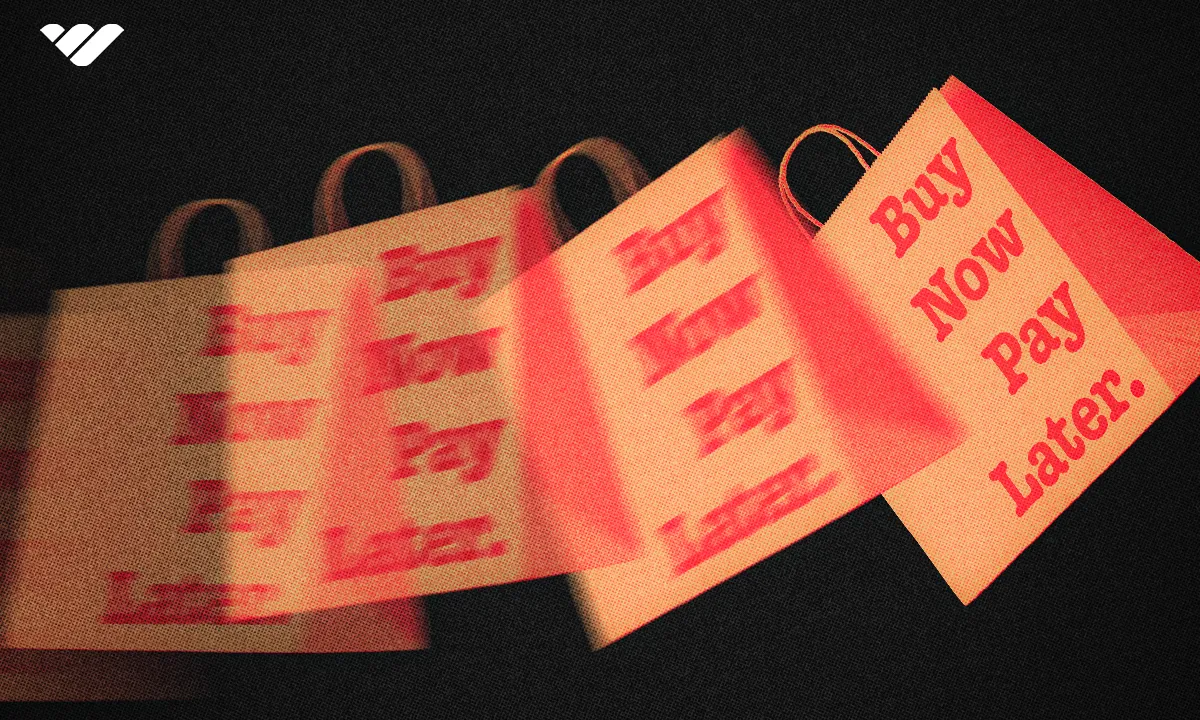Looking for the best Buy Now, Pay Later solution for your store? We’ve rounded up the top BNPL providers in 2026 that help businesses boost sales, improve checkout conversion, and keep customers coming back.
Key takeaways
- Global BNPL transactions are projected to reach $560 billion in 2025.
- BNPL accounted for 6% of U.S. ecommerce transaction volume in 2024.
- Over 360 million users worldwide currently use BNPL services.
- BNPL providers pay merchants immediately while customers spread payments over time.
- Merchant fees for BNPL typically range from 3% to 6% plus transaction fees.
Buy Now, Pay Later (BNPL) isn’t just a trend; it’s a proven way to boost conversions and customer loyalty.
By letting shoppers spread payments over time, your business can reduce cart abandonment and increase average order value.
With over 360 million users worldwide and this year's global BNPL transactions projected to reach $560 billion, flexible payments are shaping the future of ecommerce.
It's important to know these BNPL providers don’t replace your payment processor; they work alongside it to give shoppers flexible financing options right at checkout.
This guide breaks down the eight best BNPL providers to help you pick the right one for your needs.
Why should you offer customers a BNPL option?

BNPL gives your customers a flexible, low-friction alternative to traditional credit cards.
Most BNPL providers run soft credit checks, making them more accessible than bank-issued cards. When a shopper picks BNPL at checkout, the provider pays you immediately and takes on the customer’s debt—so your cash flow stays steady while your customer pays over time (sometimes with a down payment).
How BNPL benefits businesses
BNPL benefits sellers by opening your products to a broader audience and boosting impulse buys. Someone hesitant at a $50 price tag might commit to $12 today and spread the rest over a few weeks.
And the trends back this up:
- Over a quarter of U.S. consumers report having used BNPL (2025 survey, Morgan Stanley)
- In 2024, BNPL accounted for 6% of U.S. ecommerce transaction volume, up from ~2% in 2020 (Morgan Stanley)
- Globally, the BNPL transaction market is active and growing — 2024 saw ~$334 billion in BNPL volume, with forecasts pointing to ~US$560 billion by 2025 (GlobeNewswire) (FinTech Futures)
- Among users, many cite spreading payments, convenience, and affordability as their top reasons for choosing BNPL (The Motley Fool) (DemandSage)
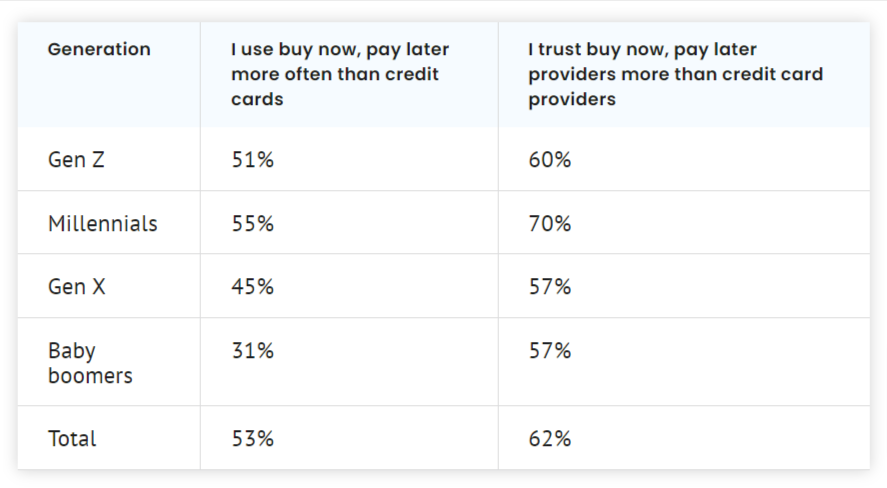
All of this tells us that BNPL is not only popular but is fast becoming a mainstream way of paying for purchases, and the trend is towards improving the customer experience by offering flexible options to pay.
The best BNPL providers
Let’s explore 8 of the top buy now, pay later providers you can add to your store:
1. Klarna
Klarna is one of the most established BNPL providers and remains a dominant force despite recent valuation challenges. The company continues to process millions of transactions daily and serves a large global customer base across more than 45 countries.
It also integrates with hundreds of thousands of merchants, giving shoppers familiarity and businesses a high-trust option.
Payment options with Klarna (U.S):
For U.S. shoppers, Klarna offers a “Pay Now” option, as well as three credit-based options:
- Pay in 4: four biweekly, interest-free installments
- Pay in 30 days: full payment due after 30 days
- Financing / Pay over time: for purchases $150+, up to 24 months
- International shoppers may also see options like “Pay in 3.”
Klarna costs and fees:
For merchants, Klarna’s standard fee structure in the U.S. is:
- Fixed fee: $0.30 per transaction
- Variable fee: between 3.29% and 5.99% of the transaction amount, depending on the agreement and the customer’s payment option
For customers, most BNPL plans are interest-free, but Klarna charges late payment fees (typically $7 per missed installment, up to a capped amount) if payments aren’t made on time.
Klarna pros and cons:
| Advantages | Disadvantages |
|---|---|
| ✅ High name recognition & trust | ❌ Late fees can be steep |
| ✅ Flexible instalment plans | ❌ Reports of ID issues |
| ✅ 0% interest for most shoppers | ❌ Reports of poor customer support |
| ✅ Soft credit checks | |
| ✅ Good ecommerce integration |
2. Affirm
Affirm is another major player in the BNPL space and has built a strong reputation since launching in 2012 under PayPal co-founder Max Levchin.
It positions itself as the “transparent” BNPL option, standing out from competitors by not charging late fees — a feature many shoppers appreciate. Instead, Affirm focuses on clear repayment terms and responsible lending.
The company partners with thousands of U.S. merchants (including Shopify) and continues to expand its reach across ecommerce. For businesses, Affirm’s brand recognition and customer-friendly policies can make it an attractive checkout option.
Payment options with Affirm for shoppers:
- Pay in 2: two equal installments
- Pay in 4: four biweekly installments
- Pay in 30: full payment due after 30 days
- Monthly installments: spread purchases over 3–60 months (interest may apply)
Minimum purchase amounts apply, and for larger transactions (up to $30,000), Affirm may require a down payment.
Affirm costs and fees:
- For customers, shorter-term plans are typically interest-free, while longer-term financing can carry interest rates from 0% to 36% APR depending on credit.
- For merchants, Affirm charges a fixed transaction fee plus a variable percentage, averaging around 6% + $0.30 per sale.
Overall, Affirm’s focus on transparency, multiple repayment options, and broad adoption make it a reliable BNPL partner — especially for merchants prioritizing customer trust and flexibility.
Affirm pros and cons:
| Advantages | Disadvantages |
|---|---|
| ✅ No late fees (big differentiator vs. Klarna/Afterpay) | ❌ Merchant fees are relatively high (often ~5–6% + $0.30) |
| ✅ Transparent terms and clear repayment schedules | ❌ Interest rates on long-term plans can be steep (up to 36%) |
| ✅ Multiple repayment options (short-term and monthly) | ❌ Some reports of customer support/ID verification issues |
| ✅ Strong U.S. presence and Shopify partnership | ❌ Minimum purchase required ($50, up to $30k cap) |
| ✅ High brand credibility (founded by PayPal co-founder) |
3. Cash App Afterpay
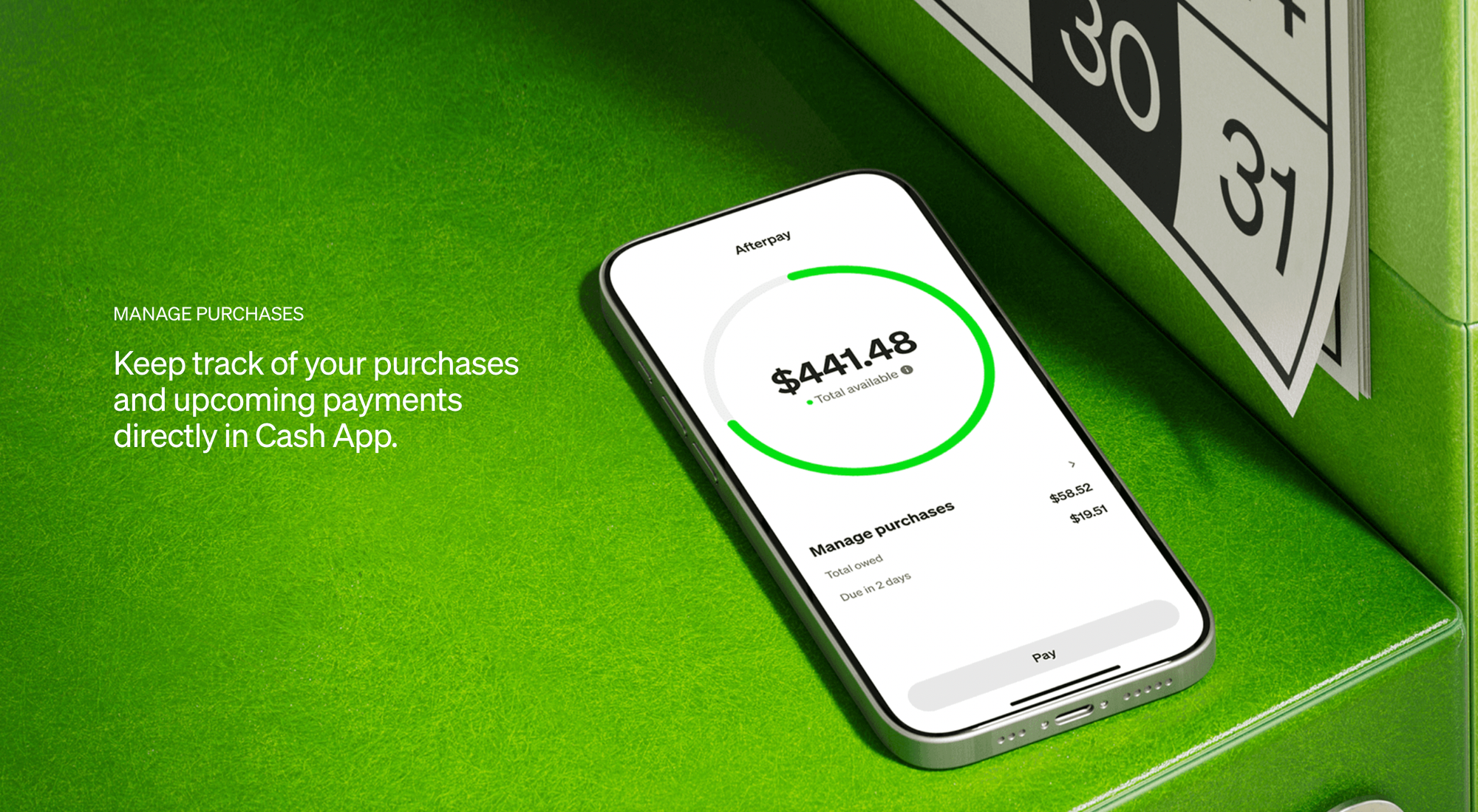
Afterpay's integration with Cash App has expanded its reach, especially among younger, mobile-first shoppers.
Data shows Cash App Afterpay customers tend to spend more per transaction and shop more frequently than traditional customers, making it an appealing option for retailers.
The service is heavily app-based, encouraging customers to manage purchases and payments through Cash App. For retailers, Afterpay is marketed as a way to capture millennial and Gen Z buyers with a seamless checkout experience.
Head's up: If you operate in Europe, customers will know this provider as Clearpay.
Payment options with Afterpay (U.S):
- Pay in 4: four equal installments over six weeks, interest-free
- Pay Monthly: six- or twelve-month plans, with APRs ranging from 6.99% to 35.99%
- Eligible customers may also qualify for “no down payment” offers
Cash App Afterpay Card:
Customers can use a digital Afterpay Card for in-store purchases where Apple Pay, Google Pay, and Samsung Pay are accepted. A paid Afterpay Card Plus tier ($9.99/month) allows broader usage with the Pay in 4 plan.
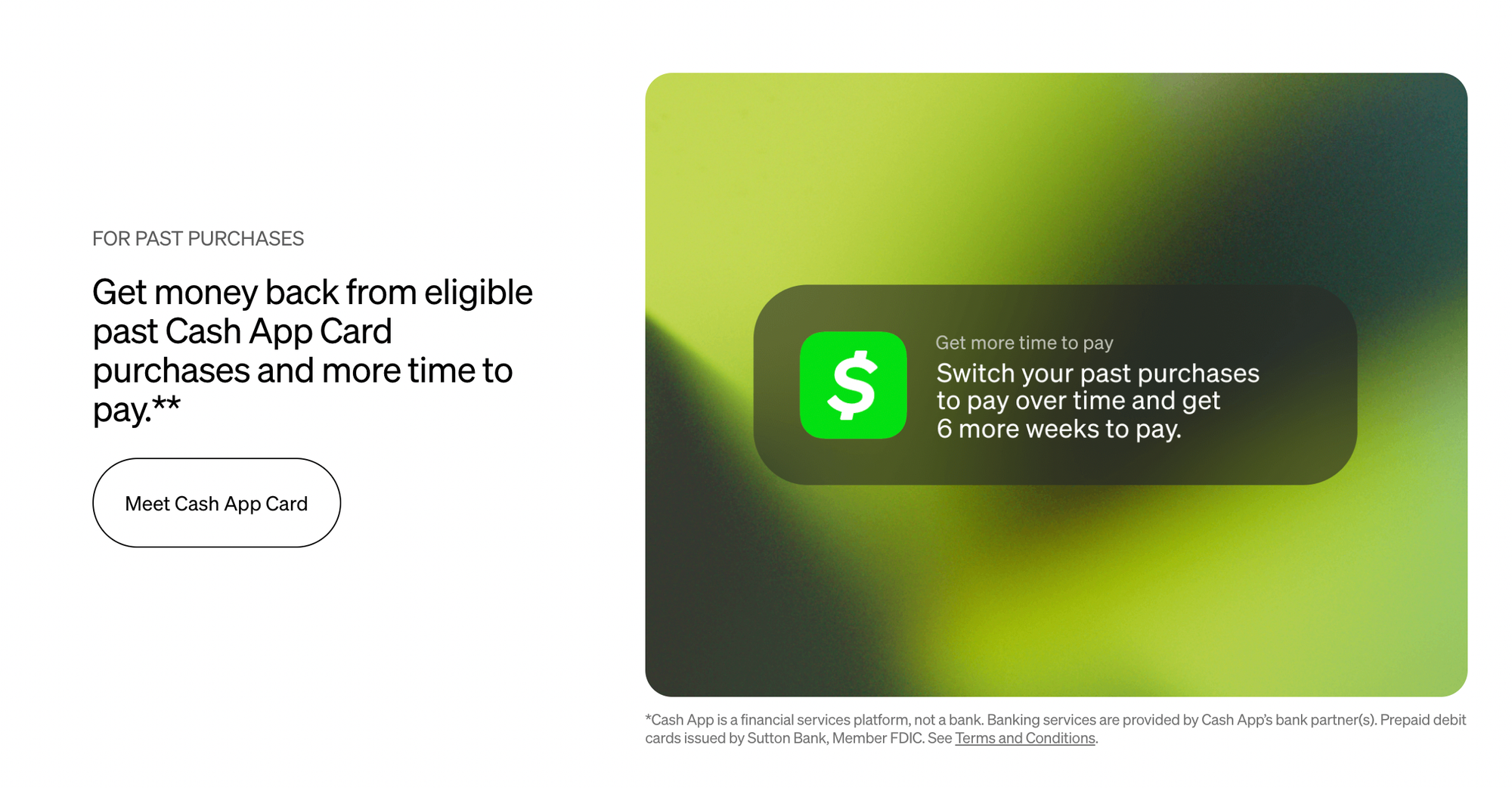
Afterpay costs and fees (U.S):
For customers, Pay in 4 is interest-free, while Pay Monthly plans carry variable APRs. Afterpay does charge late fees, but Block reports that the vast majority of payments (over 95%) are made on time.
For merchants, fees are typically a $0.30 transaction fee plus 4–6% of the sale, though exact terms depend on the agreement.
Cash App Afterpay pros and cons:
| Advantages | Disadvantages |
|---|---|
| ✅ Backed by Block (Square) and integrated with Cash App | ❌ Merchant fees can be high (around 4–6% + $0.30) |
| ✅ Strong appeal to millennial & Gen Z shoppers | ❌ Interest rates on Pay Monthly plans can reach 35.99% |
| ✅ Interest-free Pay in 4 option | ❌ Late fees still apply (though most users pay on time) |
| ✅ App-first experience with smooth in-store + online use | ❌ Limited repayment flexibility compared to Affirm |
| ✅ Afterpay Card and Card Plus expand usage in stores | ❌ Regional naming differences (Clearpay in Europe) may confuse customers |
4. FuturePay
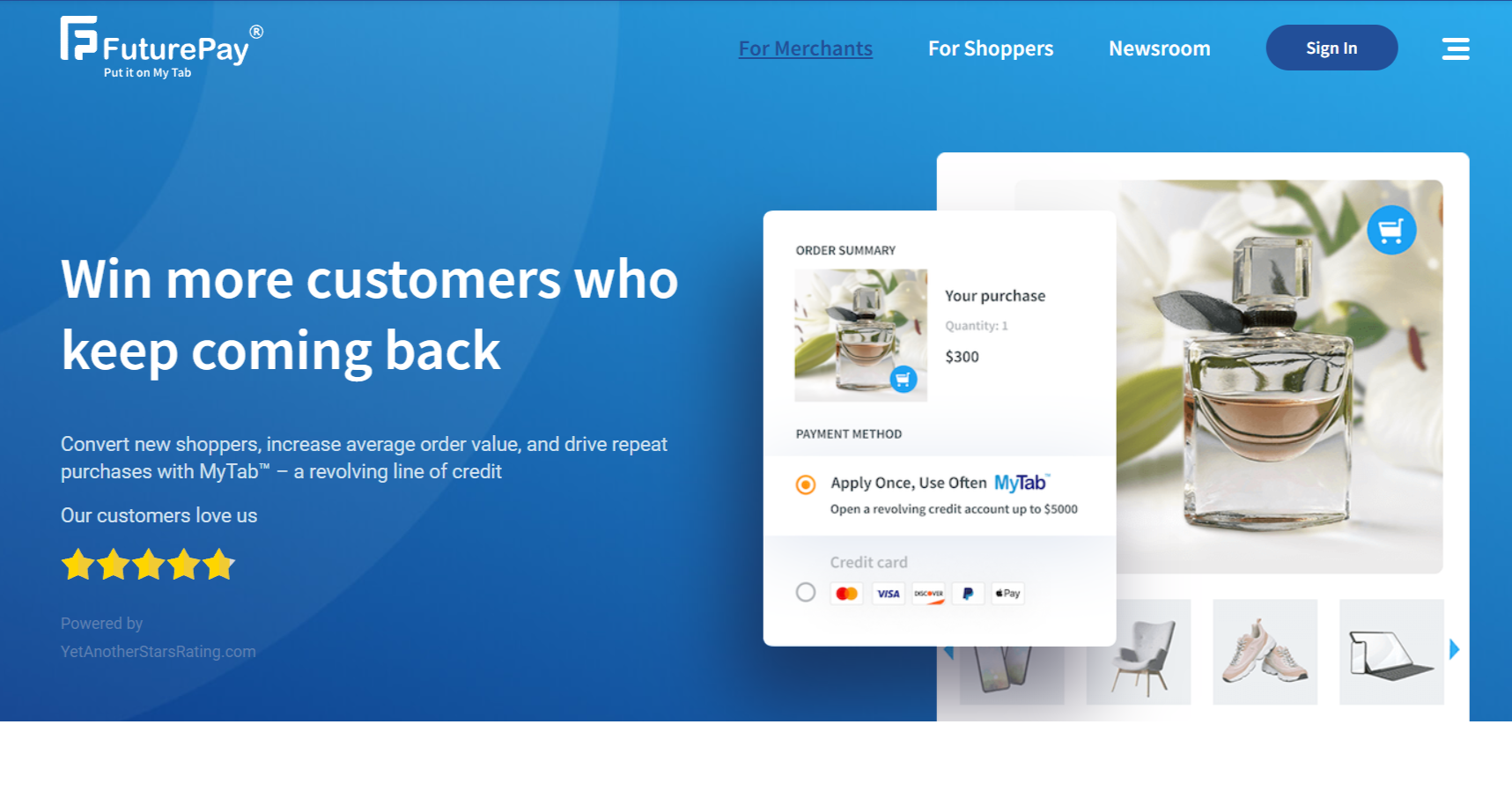
FuturePay takes a different approach to BNPL with its MyTab digital revolving credit platform.
Instead of fixed installment plans, shoppers receive a revolving line of credit — much like a store card — and pay it off in monthly installments. This gives customers flexibility, but it lacks the predictability of structured “Pay in 4” or “Pay Monthly” plans.
The MyTab Virtual Store Card offers credit lines between $1,000 and $5,000, and customers can keep accounts open long-term (some report 7+ years).
For retailers, FuturePay integrates with major ecommerce platforms including Shopify, Magento, Shift4Shop, and PrestaShop, and it claims merchants see up to 37% more first-time purchasers when MyTab is available.

Payment options with FuturePay:
Just one – a line of credit. So, customers can make purchases and pay them off monthly like a credit card. FuturePay’s minimum payments are $20 a month.
FuturePay costs and fees:
Customers pay a $1.25 fee per $50 carried over each month, a $25 annual membership fee, and late/returned payment fees up to $38.
Retailers pay a 3% merchant fee on order values, with no extra platform fees.
FuturePay pros and cons:
| Advantages | Disadvantages |
|---|---|
| ✅ Good ecommerce integration | ❌ No fixed instalment BNPL plan |
| ✅ Free for merchants to add | ❌ Lower uptake than some rivals |
| ✅ Positive retailer reviews | ❌ High fees for shoppers |
| ✅ Simple fee structure |
5. Pay Later by PayPal
PayPal has also carved out a strong position in the BNPL market. With millions of merchants already using PayPal for online checkout, adding BNPL is seamless and comes with high shopper recognition and trust.
PayPal’s BNPL offering is built into its platform and works much like its competitors, though eligibility depends on the purchase type, value, and merchant.
As with others, merchants are paid upfront while PayPal manages repayment from customers. In addition, PayPal Credit provides a revolving credit line for larger purchases.
Payment options (U.S):
PayPal offers U.S. customers three credit-based payment options:
- Pay in 4: four equal, interest-free installments over six weeks (for purchases $30–$1,500)
- Pay Monthly: spread $199–$10,000 over 6, 12, or 24 months (APR ranges 10%–36%)
- PayPal Credit: revolving line for purchases $99+, with promotional zero interest if paid in full within six months
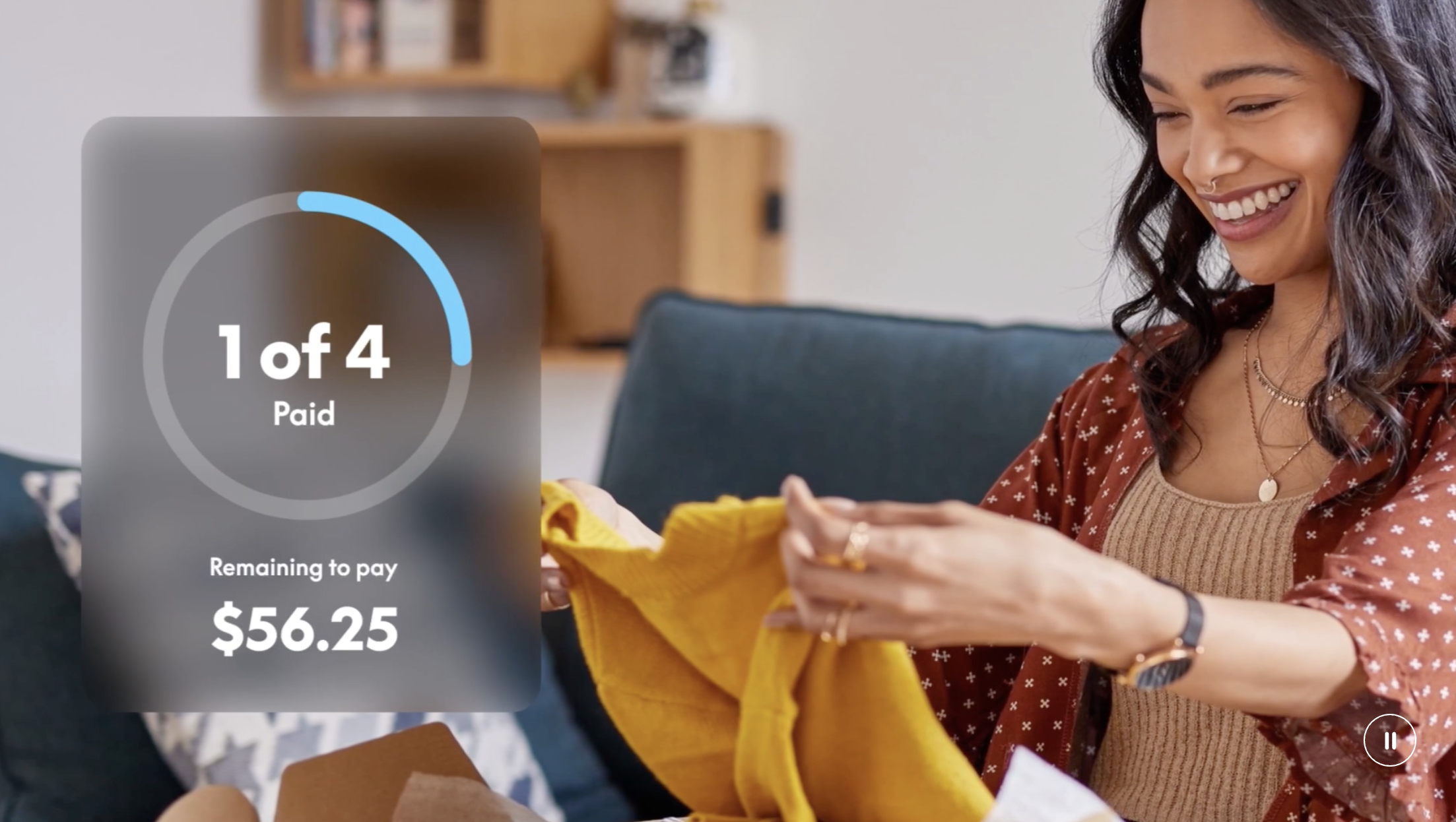
PayPal costs and fees (U.S):
- For customers: Pay in 4 is interest-free, and Pay Monthly carries variable interest. PayPal does not charge late fees on installment plans. For PayPal Credit, unpaid balances incur interest (29.24% APR) and late fees up to $41.
- For merchants: Standard PayPal processing fees apply — 4.99% + $0.49 per BNPL transaction (as of January 2025). These apply whether or not customers use BNPL, since it’s tied to PayPal’s checkout system.
PayPal pros and cons:
| Advantages | Disadvantages |
|---|---|
| ✅ Massive global brand recognition & trust | ❌ BNPL eligibility limited by purchase type and value |
| ✅ Seamless integration with existing PayPal checkout | ❌ Interest on Pay Monthly can be high (up to 35.99%) |
| ✅ Multiple financing options (Pay in 4, Pay Monthly, PayPal Credit) | ❌ PayPal Credit charges high APR (29.24%) and late fees |
| ✅ No late fees on Pay in 4 or Pay Monthly | ❌ Merchant fees apply whether or not customers use BNPL |
| ✅ Huge merchant network and customer base | ❌ Fewer BNPL features compared to Klarna or Affirm |
6. Sezzle
Sezzle has grown into a BNPL provider with over 13 million consumers and 39,000 active merchants.
It stands out as a certified B Corporation, highlighting its commitment to social and environmental standards.
Customers appreciate Sezzle’s flexibility, including the ability to reschedule a payment for up to two extra weeks — something most rivals don’t allow.
Sezzle integrates with major ecommerce platforms like Shopify, WooCommerce, and BigCommerce, and claims shoppers spend an average of 22% more per order when Sezzle is available. The company also offers Sezzle Up, a feature that lets users build credit by reporting on-time payments to credit bureaus.
Payment options with Sezzle (U.S):
- Pay in 2: 50% upfront and 50% two weeks later
- Pay in 4: four equal installments over six weeks (25% down at checkout)
- Pay Monthly: long-term financing for up to 48 months, depending on eligibility
Extras: Sezzle also offers a Virtual Card for online and in-store purchases, plus Sezzle Premium, which rewards users with discounts and perks.
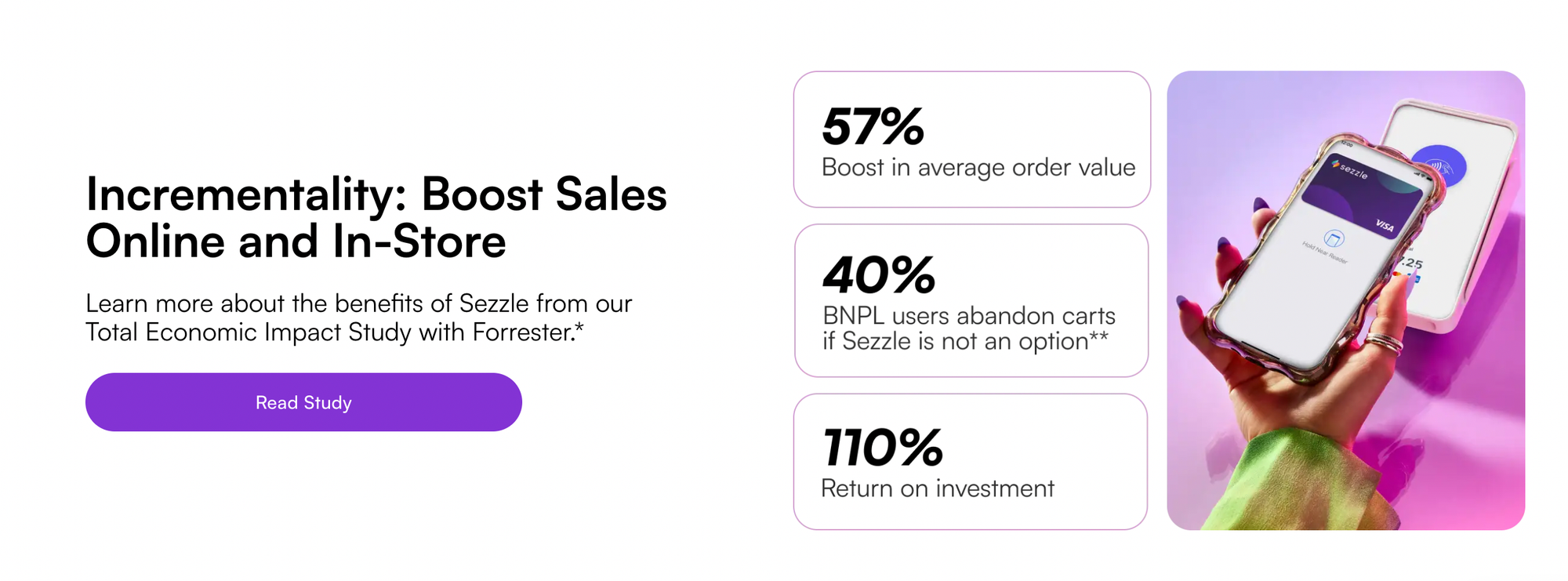
Sezzle costs and fees (U.S):
- For customers: Pay in 2 and Pay in 4 are interest-free. Pay Monthly carries interest ranging from 5.99% to 34.99%. Users may face late fees, rescheduling fees, failed payment fees, convenience fees, and service fees — though one free reschedule is included.
- For merchants: Fees typically run about $0.30 per transaction + 6% of order value, with no setup costs. Merchants processing less than $300 in a 30-day period are charged a $15 monthly fee.
Sezzle pros and cons:
| Advantages | Disadvantages |
|---|---|
| ✅ Certified B Corporation with social & environmental focus | ❌ Merchant fees are higher than many competitors (around 6% + $0.30) |
| ✅ Flexible rescheduling (one free reschedule, up to two weeks) | ❌ Wide range of customer fees (late, rescheduling, failed payment, service fees) |
| ✅ Multiple payment structures (Pay in 2, Pay in 4, Pay Monthly) | ❌ Interest on long-term financing can be steep (up to ~34.99%) |
| ✅ Credit-building option via Sezzle Up | ❌ $15 monthly fee for merchants under $300 volume |
| ✅ Strong ecommerce integrations (Shopify, WooCommerce, BigCommerce) | ❌ Smaller user base compared to Klarna, Affirm, PayPal |
7. Splitit
Splitit takes a unique approach to BNPL by working with a shopper’s existing credit card instead of issuing a separate loan or line of credit.
At checkout, Splitit pre-authorizes the full purchase amount on the card, then automatically charges installments until the balance is paid off.
This means shoppers don’t undergo additional credit checks — they’re simply leveraging their current credit card limit but in a more budget-friendly, installment-based way. For customers, the benefit is avoiding interest charges while still spreading out payments.
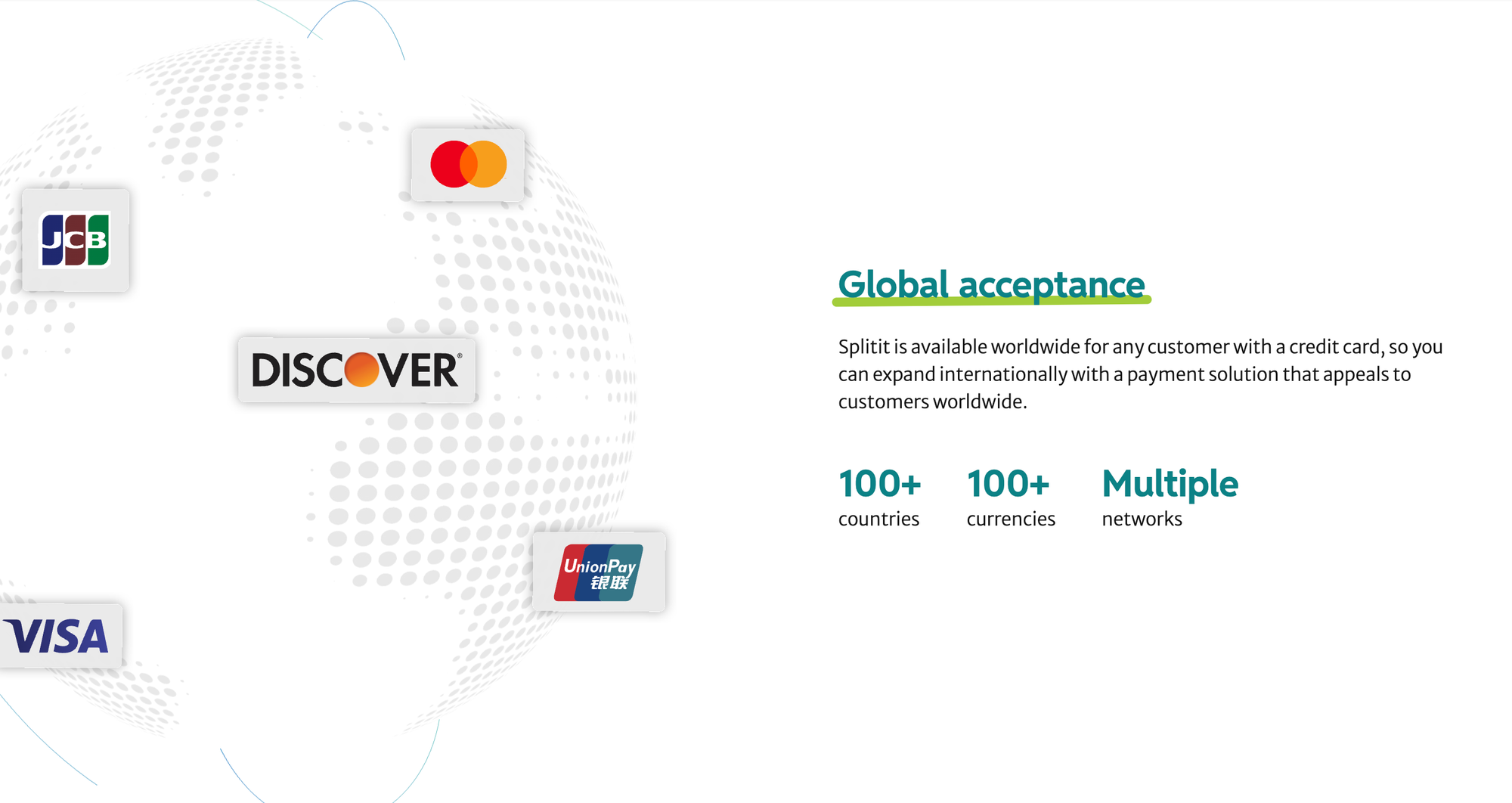
Splitit integrates with major ecommerce platforms like Whop, Shopify, WooCommerce, and Magento, and reports industry-leading conversion rates of over 85%.
Merchants also note higher order values, with an average purchase exceeding $1,000.
Payment options with Splitit:
- Installment payments using an existing credit card (up to 36 months)
- Subscription-based installment plans
- Interest-free loan structures for eligible purchases
- Works with Visa, Mastercard, American Express, Discover, and UnionPay (merchant-dependent)
Retailers can also offer a “Pay after delivery” feature, allowing trusted customers to receive their order before the first payment is processed.
Splitit costs and fees:
- For customers: No added interest or late fees from Splitit (only subject to the credit card provider’s terms if payments fail). Customers must have the total purchase balance available on their card.
- For merchants: Fees range from 1.5% to 6.5% per transaction plus a flat fee, depending on whether the merchant wants full upfront settlement or is willing to accept installment payouts.
Splitit pros and cons:
| Advantages | Disadvantages |
|---|---|
| ✅ No interest or late fees charged by Splitit | ❌ Requires a valid credit card |
| ✅ No separate line of credit needed | ❌ Card must cover the full purchase amount upfront |
| ✅ Integrates with major ecommerce platforms | ❌ Limited global awareness compared to bigger BNPL brands |
| ✅ High conversion rates and strong order values |
8. Shop Pay Installments
Shop Pay Installments is Shopify’s native BNPL solution, designed specifically for merchants using the Shopify platform.
It allows customers to split purchases into smaller payments directly through the Shop Pay checkout flow — no need to integrate a third-party provider.
Because it’s powered by Affirm in the U.S., merchants get the trust of an established BNPL partner while keeping the checkout process branded under Shop Pay.
Shop Pay Installments is best suited for Shopify merchants who want a BNPL option built into their existing checkout, with no extra integrations. It’s not as flexible as standalone BNPL providers, but its native integration and customer familiarity make it a convenient, high-trust choice.
Payment options (U.S.):
- Pay in 4: four interest-free installments for orders between $50 and $999
- Monthly installments: spread purchases from $150 to $17,500 over 3–12 months (interest may apply depending on eligibility)
Costs & fees:
- For customers: Pay in 4 is interest-free, while monthly installment plans carry APRs from 10%–36% depending on creditworthiness. No late fees are charged.
- For merchants: Shopify deducts a processing fee of 5.9% + $0.30 per BNPL transaction. These fees are higher than Shopify’s standard payment rates, so retailers need to factor them into pricing.
Shop Pay pros and cons:
| Advantages | Disadvantages |
|---|---|
| ✅ Native to Shopify checkout (no extra setup) | ❌ Only available to Shopify merchants |
| ✅ Powered by Affirm, adding trust & reliability | ❌ Merchant fees are higher (5.9% + $0.30) |
| ✅ Simple, seamless checkout experience for customers | ❌ Limited repayment options compared to competitors |
| ✅ Interest-free “Pay in 4” option | ❌ Monthly plans can carry high APRs (up to 36%) |
| ✅ Mobile-friendly and recognizable for Shopify shoppers | ❌ Smaller global footprint than Klarna, PayPal, or Afterpay |
9. Zip Pay
Zip Pay is a Buy Now, Pay Later provider that lets U.S. customers split purchases into four interest-free payments over six weeks.
Unlike platform-native BNPL options, Zip works across thousands of online stores and most major ecommerce platforms, including Whop, Shopify, BigCommerce, WooCommerce, and custom sites via its API and payment widget.
Zip is best suited for merchants that want a flexible, widely adopted Pay-in-4 option without switching processors or migrating their checkout.
It’s not as feature-rich as enterprise BNPL tools, but it offers broad retail coverage, strong brand recognition, and simple implementation.
Payment options (U.S.):
- Pay in 4: Four interest-free payments in weekly, twice monthly, or monthly instalments.
Costs & fees:
- For customers: Pay-in-4 is interest-free. Monthly account fees waived for timely repayments, but account and late fees apply if repayments aren’t made on time.
- For merchants: Merchant fees vary by industry and risk profile (Zip generally charges a percentage of the transaction plus a fixed fee, higher than standard card processing rates).
Sell more, get paid faster, and offer BNPL with Whop

Whop is the all-in-one platform to build, sell, and scale your ecommerce business.
Sell anything from courses and coaching to memberships and digital services, all while giving your customers flexible ways to pay with Whop Payments:
- Low transparent fees (2.7% + 30¢)
- No monthly fees
- Payouts in 170+ countries
- Smart routing to boost transaction rates
- BNPL options with Klarna, Sezzle, Splitit, and Afterpay
BNPL lets you confidently sell more high-ticket offers like masterminds, live coaching, or premium programs while letting customers spread the cost.
More accessibility for them, higher conversions for you.
Ready to grow? Check out Whop Payments — your one-stop shop for powering sales and scaling your business.
BNPL FAQs
What should I look for in a BNPL company?
As a retailer, the most important factor is the approval (or acceptance) rate — the percentage of shoppers who actually get approved for financing. Low approval rates mean frustrated customers and abandoned carts.
While exact numbers are rarely shared, younger shoppers tend to have lower approval odds than older groups. Look for a provider known for high approval rates and broad accessibility.
Other key factors to consider:
- Ease of integration with your ecommerce platform
- Variety of payment options (Pay in 4, monthly financing, revolving credit, etc.)
- Merchant fees (transaction percentages and flat fees)
- Risk management (fraud prevention, credit checks, repayment strategies)
- Customer experience (support, reviews, reputation)
What happens if a BNPL customer misses a payment?
You don’t take on the risk. As the merchant, you’re paid upfront in full. Missed payments are between the customer and the BNPL provider. Consequences depend on the provider — usually late fees, account freezes, or restrictions on future purchases.
In some cases, long-term nonpayment may result in debt being sent to a collection agency.
Can customers still make returns if they used BNPL?
Yes. The process works just like a normal return. You issue a refund to the BNPL provider, and they update the customer’s repayment plan or credit line. This ensures the shopper’s account reflects the return correctly.
Are BNPL providers regulated?
Regulation is catching up. For years, BNPL operated in a gray area outside of traditional financial oversight. Now, regulators in the U.S. and abroad are tightening rules to protect consumers and ensure ethical practices.
For you, this is good news: working with a regulated provider builds trust and reduces reputational risk if customers complain about their experience.


